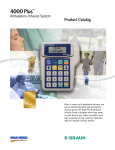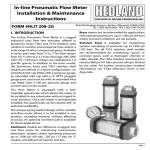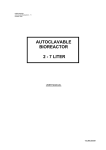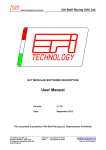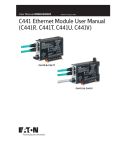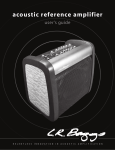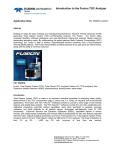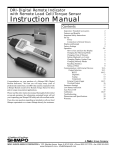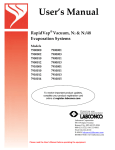Download - Scientific Systems
Transcript
Ultra-High Pressure Series III Analytical HPLC Pump — Single Piston For Fast Chromatography and LC/MS Applications Operator’s Manual 90-2806 REV B Scientific Systems, Inc. 349 N. Science Park Road State College, PA 16803 www.ssihplc.com Phone: 800-441-4752 Fax: 814-238-7532 Email: [email protected] SAFETY SYMBOLS EARTH GROUND CAUTION - REFER TO MANUAL CAUTION HIGH VOLTAGE Scientific Systems, Inc. 349 North Science Park Road, State College PA 16803 Phone: 800-441-4752 / 814-234-7311 Fax: 814-238-7532 Email: [email protected] www.ssihplc.com www.ssipumps.com TABLE OF CONTENTS 1 INTRODUCTION .................................................................................................... 1-1 1.1 Description of the Ultra-High Pressure Series III Pump ......................................... 1-1 1.1.1 Pump Features ....................................................................................................... 1-1 1.1.2 Wetted Materials .................................................................................................... 1-1 1.1.3 Self-Flushing Pump Heads..................................................................................... 1-2 1.1.4 Self-Flush and Seal Life ......................................................................................... 1-2 1.2 Specifications and Features for the Ultra-High Pressure Series III Pump............ 1-3 2 INSTALLATION ..................................................................................................... 2-1 2.1 Unpacking and Inspection ........................................................................................ 2-1 2.2 Location/Environment ............................................................................................... 2-1 2.3 Fluid Connections & Priming .................................................................................... 2-1 2.4 Electrical Connections .............................................................................................. 2-3 2.5 Solvent Preparation ................................................................................................... 2-3 2.5.1 Solvent Out-gassing and Sparging......................................................................... 2-3 2.5.2 Cavitation ............................................................................................................... 2-3 2.5.3 Filtration.................................................................................................................. 2-4 2.5.4 Solvents With Harmful Effects ................................................................................ 2-4 2.6 Instrument Installation............................................................................................... 2-5 2.6.1 Mobile Phase Reservoirs ....................................................................................... 2-5 2.6.2 Self-Flush Solution ................................................................................................. 2-5 2.6.3 Inlet Tubing and Filters ........................................................................................... 2-5 2.6.4 Outlet Tubing .......................................................................................................... 2-5 2.6.5 Priming the Pump and the Flushing Lines.............................................................. 2-5 2.6.6 Long Term Pressure Calibration Accuracy............................................................. 2-6 2.7 Preparation for Storage or Shipping ........................................................................ 2-6 2.7.1 Methanol Flush ....................................................................................................... 2-6 2.7.2 Packaging for Shipping .......................................................................................... 2-6 3 OPERATION .......................................................................................................... 3-1 3.1 Front Panel Controls and Features .......................................................................... 3-1 3.1.1 Prime Valve ............................................................................................................ 3-2 3.1.2 Filter/Outlet ............................................................................................................. 3-2 3.1.3 Control Panels / LCD Display ................................................................................. 3-2 3.2 Rear Panel Remote Input........................................................................................... 3-6 4 MAINTENANCE ..................................................................................................... 4-1 4.1 Filter Replacement ..................................................................................................... 4-1 i 4.1.1 Inlet Filters .............................................................................................................. 4-1 4.1.2 Outlet Filter (inside Check Tee).............................................................................. 4-2 4.2 Changing Pump Heads .............................................................................................. 4-3 4.2.1 Removing the Pump Head ..................................................................................... 4-3 4.2.2 Cleaning the Pump Head Assembly....................................................................... 4-4 4.2.3 Replacing Piston Seals .......................................................................................... 4-5 4.2.4 Changing the Piston ............................................................................................... 4-6 4.2.5 Replacing the Pump Head ..................................................................................... 4-6 4.3 Conditioning New Seals ............................................................................................ 4-7 4.4 Check Valve Cleaning ................................................................................................ 4-7 4.5 Pulse Damper Replacement ...................................................................................... 4-7 4.5.1 Removing the Pulse Damper ................................................................................. 4-7 4.5.2 Pulse Damper Refurbishing ................................................................................... 4-8 4.5.3 Pulse Damper Installation ...................................................................................... 4-8 4.6 Cleaning the Pump..................................................................................................... 4-8 4.7 Cleaning the Cabinet ................................................................................................. 4-8 4.8 Lubrication.................................................................................................................. 4-8 4.9 Fuse Replacement ..................................................................................................... 4-9 4.10 Battery Replacement (if applicable) ....................................................................... 4-10 4.11 Preventive Maintenance .......................................................................................... 4-11 5 QUICK GUIDE TO PROBLEM SOLVING.............................................................. 5-1 6 LIST OF REPLACEMENT PARTS ........................................................................ 6-1 6.1 Standard Spare Parts, 5 mL, Stainless Steel ........................................................... 6-1 7 APPENDIX A .......................................................................................................... 7-1 7.1 Rear Panel Serial Communications Port ................................................................. 7-1 7.1.1 Hardware Implementation ...................................................................................... 7-1 7.1.2 Hand Shaking ......................................................................................................... 7-1 7.1.3 Command Interpreter ............................................................................................. 7-2 7.2 Rear Panel 4-Pin and 10-Pin Terminal Board Connectors ..................................... 7-4 7.2.1 Pressure Fault and Motor Stall Fault Output .......................................................... 7-4 7.2.2 General Information on Inputs ................................................................................ 7-5 7.2.3 General Information on Run, Stop, and Enable Inputs........................................... 7-5 7.2.4 Run and Stop Inputs............................................................................................... 7-5 7.2.5 Enable Input ........................................................................................................... 7-6 7.2.6 General Information on Voltage and Frequency Inputs.......................................... 7-6 8 WARRANTY STATEMENT .................................................................................... 8-1 ii 1 INTRODUCTION This operator's manual contains information needed to install, operate, perform user maintenance on, and service the SSI Ultra-High Pressure HPLC Pump. 1.1 Description of the Ultra-High Pressure Series III Pump The Ultra High Pressure Series III high performance liquid chromatography (HPLC) pump is designed to be a reliable component within a basic analytical instrument or sophisticated research instruments. The flow rate of the Ultra High Pressure pump can be set in 0.001 mL increments from 0.000 to 3.000 mL/min. 1.1.1 Pump Features Features of the Ultra-High Pressure Pump: • Stepper motor driven, single head positive displacement pump • 316 Stainless Steel fluid path • Incorporates a diaphragm-type pulse damper, which reduces pulsation in the system by as much as 90% and includes an isolated pressure transducer (i.e., the transducer adds no dead volume) • Check-Tee Outlet Filter • Ruby/Sapphire Check Valves (1/16” ball) • Front panel flow adjustment in .001 mL/min increments • Upper and Lower Pressure Limits: Automatically turns the pump OFF if the system pressure exceeds the maximum pressure limit, or drops below mimimum pressure limit • Microprocessor advanced control with advanced pre-compression algorithm and user calibration feature • Tactile response, chemically resistant LCD front panel keypad – Set points, pressure read out, alarms, etc. • Back panel RS232 serial communications port for complete control and status monitoring; EZ Chrom Driver available. • Automatic piston wash (self flush) 1.1.2 Wetted Materials Check valve bodies and tubing are made out of type 316 Stainless Steel. Other materials common to this pump are synthetic ruby and sapphire (check valve internals and piston) , PEEK™ (various sealing surfaces), and ultra-high molecular weight polyethylene (piston seal). 1-1 1.1.3 Self-Flushing Pump Heads Self-flushing pump heads provide continuous washing of the piston surface without the inconvenience of a manual flush or gravity feed arrangement. The self-flushing pump head uses a secondary seal and set of check valves to create a continuous and positive flow in the area behind the high pressure pump seal. The flushing solution washes away any buffer salts that have precipitated onto the piston. If not removed, these precipitates can abrade the high pressure seal and cause premature seal failure, leakage, and can possibly damage the pump. Figure 1-1. Self-Flushing Pump Head 1.1.4 Self-Flush and Seal Life It is recommended that the Self Flush feature be used to improve seal life in a number of applications. In particular, if pumping Buffers, Acids/Bases or any inorganic solution near saturation, the pump should utilize the Self Flush feature failure to use this feature in such applications will cause faster seal wear. With every piston stroke, an extremely thin film of solution is pulled back past the seal. If this zone is allowed to dry (without use of Self Flush), then crystals will form, which will ultimately damage the seal. Typically Water methanol or water IPA in a volumetric ratio of 80:20 is recommended. Another application where Self Flush is highly recommended is when pumping Tetrahydrofuran (a.k.a. THF) or other volatile solvents such as Acetone, Methylene Chloride etc. Volatile solvents will dry rapidly behind the seal (without the use of Self Flush), which will dry and cause friction on the seal decreasing seal life. Typically Water methanol or water IPA in a volumetric ratio of 80:20 is recommended. 1-2 1.2 Specifications and Features for the Ultra-High Pressure Series III Pump Note: Specifications are per channel, where applicable. All Stainless Steel Fluid Path except where indicated. Flow Rates .................... 0.001 to 3.000 mL/min Pressure........................ 15,000 psi Pressure Accuracy ........ ±0.5% of full-scale pressure Pulsation ....................... ± 4.00% Flow Accuracy............... < ± 2% of setting or 10 uL/min, whichever is greater, across the full flow range, 5,000 psi, with degassed methanol Flow Precision............... < 0.1% RSD or < 0.2 min SD, whichever is greater, across the full flow range, 5,000 p.s.i., with degassed methanol Automatic Pressure Compensation User-Settable Flow Rate Calibration Automatic Piston Wash (Self-Flush) UHP Pulse Dampener with 20,000 psi transducer Membrane Keypad with LCD Display Environmental ............... Indoor use only Temperature ................. 10 to 30° C Humidity ........................ 20 to 90% Relative humidity Remote Inputs............... RS-232 Dimensions ................... 5.6" high x 10.375" wide x 19.75" deep Weight ........................... 27 lb Power ............................ 100-240 Vac, 50-60 Hz, 60W EZChrom diver available 1-3 2 INSTALLATION 2.1 Unpacking and Inspection Prior to opening the shipping container, inspect it for damage or evidence of mishandling. If it has been damaged or mishandled, notify the carrier before opening the container. Once the container is opened, inspect the contents for damage. Any damage should be reported to the carrier immediately. Save the shipping container. Check the contents against the packing list. 2.2 Location/Environment The preferred environment for the Ultra-High Pressure pump is normal laboratory conditions. The area should be clean and have a stable temperature and humidity. The instrument should be located on a stable flat surface with a minimum 4-inch clearance on all sides for ventilation and the necessary electrical and fluid connections. (Reference IEC 1010 installation category II, and Pollution degree 2 environment). 2.3 Fluid Connections & Priming There are only three connections to be made: 1. Connect Pump solvent line supplied 2. Connect line to injection valve or autosampler from outlet 3. Connect the self flush inlet and outlet (opaque) tubing as shown on the the next page, if this option is included with the pump. Details on the proper installation of tubing and priming of the pump and self flush is shown on the next page. 2-1 Self-Flush Pump Connect pump inlet tubing as shown, using the “T” inlet fitting provided (“T” on dual-head only). Connect wash solution inlet and outlet tubing (opaque) to the flush housing as shown. Make sure ferrules are in the correct position. Make sure ferrules are in the correct position. Insert wash outlet tubing end into the syringe with clear adapter tube installed (provided in start-up kit). Ensure inlet line filter is submersed into solvent. Attach syringe to Prime-Purge valve Luer fitting. Open Prime-Purge valve by turning knob counterclockwise two turns. Draw syringe back to prime. Draw on syringe until no bubbles are seen. Ensure wash solution inlet tubing is submersed into wash solution vessel. Draw syringe back to prime. Remove syringe and place outlet tubing in wash solution vessel. Replace wash solution weekly. Close Prime / Purge valve and remove syringe To aid in priming, user may run pump at approx. 1 ml/min while drawing on syringe. Replace solvent weekly. Repeat procedure as required unitl pump is fully primed. Repeat procedure as required until wash is primed. 2-2 2.4 Electrical Connections Using the power cord supplied with the pump, or equivalent, plug the pump into a properly grounded electrical outlet. WARNING: Do not bypass the safety ground connection as a serious shock hazard could result. 2.5 Solvent Preparation Proper solvent preparation will prevent a great number of pumping problems. The most common problem is bubble formation, which may affect the flow rate consistency. Aside from leaky fittings, the problem of bubble formation arises from two sources: solvent out-gassing and cavitation. Filtration of HPLC solvents is also required. 2.5.1 Solvent Out-gassing and Sparging Solvent out-gassing occurs because the mobile phase contains dissolved atmospheric gases, primarily N2 and O2. These dissolved gases may lead to bubble formation and should be removed by degassing the mobile phase before or during use. The best practical technique for degassing is to sparge the solvent with standard laboratory grade (99.9+%) helium. Helium is only sparingly soluble in HPLC solvents, so other gases dissolved in the solvent diffuse into the helium bubbles and are swept from the system. Solvent filtration is not an effective alternative to helium degassing. It is recommended that you sparge the solvent vigorously for 10 to 15 minutes before using it. Then maintain a trickle sparge during use to keep atmospheric gases from dissolving back into the mobile phase. The sparged solvent must be continually blanketed with helium at 2 to 3 psi. Non-blanketed sparged solvents will have atmospheric gases dissolved back into the mobile phase within four hours. Solvent mixtures using water and organic solvents (like methanol or acetonitrile) hold less dissolved gas than pure solvents. Sparging to reduce the amount of dissolved gas is therefore particularly important when utilizing solvent mixture. Even with sparging some out-gassing may occur. A backpressure regulator installed after the detector flow cell will help prevent bubbles from forming and thus limit baseline noise. WARNING: Always release pressure from the pump slowly. At Ultra High Pressures, a significant amount of energy is stored and released due to fluid compressibility. A rapid release of pressure could cause the pulse dampener diaphragm to rupture. The use of safety glasses is highly recommended (regardless of solvent used). 2.5.2 Cavitation Cavitation occurs when inlet conditions restrict the flow of solvent and vapor bubbles are formed during the inlet stroke. The key to preventing cavitation is to reduce inlet restrictions. The most common causes of inlet restrictions are 2-3 crimped inlet lines and plugged inlet filters. Inlet lines with tubing longer than 48" (120 cm) or with tubing of less than 0.0625" (1.5 mm) ID may also cause cavitation. The use of the standard 1/8” OD tubing that was supplied with this pump is highly recommended. Placing the solvent reservoirs below the pump level also promotes cavitation. The optimal location of the reservoirs is slightly above the pump level, but it is adequate to have them on the same level as the pump. 2.5.3 Filtration Solvent filtration is good practice for the reliability of the Ultra-High Pressure pump and other components in a HPLC system. Solvents should always be filtered with a 0.5 micron filter prior to use. This ensures that no particles will interfere with the reliable operation of the piston seals and check valves. Solvents in which buffers or other salts readily precipitate out will need to be filtered more often. After filtration, the solvents should be stored in a closed, particulate-free bottle. 2.5.4 Solvents With Harmful Effects All portions of the Ultra-High Pressure pump that contact mobile phase are manufactured of type 316 stainless steel, sapphire, ruby, ultra high molecular weight polyethylene (UHMWPE) or fluorocarbon polymer. Some of these materials are extremely sensitive to acids (including some Lewis acids) and acid halides. Avoid using solvents that contain any amount of hydrochloric acid. Some solvents you specifically avoid are: Aqua Regia Bromine Chlorine Anhydrous Copper Chloride Ferric Chloride Ferrous Chloride Freon 12 (wet) Guanidine Hydrobromic Acid Hydrochloric Acid Hydrofluoric Acid Hydrofluorsilicic Acid Hydrogen Peroxide Iodine Mercuric Chloride In addition, some users of HPLC systems have observed that chloroform and carbon tetrachloride slowly decompose to liberate hydrochloric acid, which, as noted above, attacks stainless steel. Do not leave these solvents in the systems for a prolonged period. You may also want to avoid ammonium hydroxide. Although ammonium hydroxide will not harm the pump itself, it is likely to damage the stator and rotor in injection valves. 2-4 2.6 Instrument Installation 2.6.1 Mobile Phase Reservoirs The mobile phase reservoir should be placed at the same level or slightly higher than the pump, never below the pump, and the inlet tubing should be as short as practical. These steps minimize pressure losses on the inlet side of the pump during refill and help to avoid bubble formation. These steps are particularly important when using high vapor pressure solvents (hexane, methylene chloride, etc.). Mobile phases should be degassed, filtered and covered. (See Section 2.5.) 2.6.2 Self-Flush Solution Self-flush heads typically require 250-500 mL of 20% methanol in water as a flushing solution. A pH indicator that will indicate the concentration of salts in the solution is recommended as a reminder to change the solution. This flush solution should be replaced with a fresh solution weekly to avoid frequent pump maintenance. Alternate wash solutions may be used depending on the liquids used for the application. Contact the manufacturer for specific recommendation. WARNING: If your pump has the self-flush feature installed, and if you do not use the self-flush feature of this pump, you must carefully remove the selfflush seal with the seal tool provided, and replace with the guide bushing provided. If this procedure is not completed, low flow rates, excessive noise and shortened pump life will result. 2.6.3 Inlet Tubing and Filters Solvent enters through the white polyethylene (field replaceable) 20 micron slip-on inlet filter, through the black PEEK inlet filter holder, then passes through a 48” (91 cm) length of tubing (0.0625” ID, 1/8” OD), then splits into each pump head through a tefzel tee and a short 3 3/8” and 1 ¾” section of blue tubing. The fluid path connections include a combination of PEEK black flangeless nuts and the tefzel flange seat ferrules. 2.6.4 Outlet Tubing Outlet tubing (not supplied with the pump) should have a 1/16" outer diameter. The tubing for the Ultra High pump should be 316 stainless steel. The tubing must be cut squarely with no burrs. The tube itself should not be crimped and the center hole must be open. A tubing cutter is recommended for cutting stainless steel tubing. Do not use PEEK™ tubing with the Ultra High Pressure pump because it will burst under the normal operating pressures that are routinely used with this pump. 2.6.5 Priming the Pump and the Flushing Lines Be sure all of the connections downstream of the pump outlet are closed. Set the flow rate* to about 2-3 mL/min. Open the valve 1 to 2 turns (counterclockwise) and attach a syringe to the Luer port. Place the pump in RUN 2-5 mode*. Draw about 10-20 ml of mobile phase. STOP the pump *. Close the valve. Repeat as required. *See Section 3.1.3 for pump control procedures. To prime the flush lines for a self-flush head, connect a syringe and pull 10-20 mL of flush solution through the outlet line (typically the right head flush outlet). 2.6.6 Long Term Pressure Calibration Accuracy The electronic pressure transducer has been zeroed and calibrated at the factory. Over the life of the pump, some drift may occur. For example, it is typical for the zero to drift < 10 psi. after about 1 year of operation (i.e., with no back pressure on the pump a reading of 1-9 psi. may be displayed). A similar drift may also occur at higher pressures, and are typically less than 1% (e.g. <50 psi. at 6,000 psi. back pressure). If pressure calibration and/or drift are a concern, consult the factory. The pump can be shipped back to the factory for recalibration. Alternatively, written calibration and zero-reset procedures are available. Consult the factory to receive these instructions. 2.7 Preparation for Storage or Shipping 2.7.1 Methanol Flush Disconnect the outlet tubing from the pump. Insert the inlet filter in methanol. Open the prime valve and use a syringe to draw a minimum of 50 mL. Close the prime valve and pump a minimum of 5 mL of methanol to exit. Leave the inlet tubing connected to the pump. Place the inlet filter in a small plastic bag and attach it to the tubing with a rubber band. Plug the outlet port with the shipping plug, leave a length of outlet tubing on the pump, or cover the outlet port with plastic film. 2.7.2 Packaging for Shipping CAUTION: Re-package in the original carton, if possible. If the original carton is not available, wrap the pump in several layers of bubble wrap and cushion the bottom, top, and all four sides with 2" of packaging foam. Although heavy, an HPLC pump is a delicate instrument and must be carefully packaged to withstand the shocks and vibration of shipment. 2-6 3 OPERATION 3.1 Front Panel Controls and Features Figure 3-1. Ultra-High Pressure Series III Pump Front Panel 3-1 3.1.1 Prime Valve The prime valve vents the flow to atmosphere and permits efficient priming of the Ultra-High Pressure pump. When the valve is closed (fully clock-wise) firmly, high-pressure flow is directed to the Filter/Outlet port. When the valve is opened (counter clock-wise) one-half to one full turn, pressure is vented and flow exits through the drain port in the prime valve stem assembly. Suction with a Luer tip syringe at the drain port will purge air bubbles from the pump and reservoir lines (provided there are no open valves to lines down¬stream at the injector/column interface). See Section 2.6.5 for complete priming instructions. 3.1.2 Filter/Outlet A high-pressure in-line filter (0.5 micron rating) is included at the output of the Ultra-High Pressure pump. The Filter/Outlet port is the high-pressure filter closure and is designed for a 1/16" OD tubing connection. 3.1.3 Control Panels / LCD Display 3.1.3.1 Digital Display Upon power-up, a start-up screen (or splash screen) indicates the model name and firmware revision.This screen shows only momentarily. NOTE: Example only. The firmware version on your actual pump may vary from the photo above. 3-2 3.1.3.2 Keypad General keypad operation is shown in the table below. Refer to specific instructions that follow. Run/ Stop When pressed, this button alternately starts and stops the pump. Enter Accepts newly changed entry values. Mode Use this button to cycle through the menu levels and the entry fields. > Moves cursor to right < Moves cursor to left + Increases the number value over the cursor - Decreases the number value over the cursor 3-3 3.1.3.3 Status Indicators and Change in Set Points MAIN MENU (Screen One – After Splash Screen) Flow The digital display shows flow rate in mL/min. Press The digital display shows system pressure in psi. RUN Indicates pump is running STOP Indicates pump is stopped FAULT Indicates fault has occurred and the pump has stopped First, press the Mode key to allow modification of the flow rate set point. A cursor will appear below the field to be changed. Right and left arrows(<>) move the cursor to the desired place within the field to be changed. Mode key will index to the next field. The cursor is set below the digit that will be changed. +/- keys scroll number values up or down with the displayed value changing based on the location of the cursor. For example, 2.480 cursor under the “8”, will increment to 2.490 one the first press of the + and to 2.500 on the next press of the +. Flow rate changes are immediately accepted when the pump is not running. If the pump is running, flow rate changes will require the Enter key to be pressed for the new flow rate to be entered. Pressure Faults or Stall Faults are cleared by pressing the Run/Stop key. All Fault conditions are displayed on this screen. If a Fault occurs while in any other screen, the display will automatically switch back to this Main Menu. The Fault is cleared from this screen, as indicated above. The next menu screen is accessed by pressing the Mode key after the Cursor is on the Flow position on this screen one. 3-4 PRESSURE LIMITS SETUP MENU (Screen Two) Upper Displays the user-set upper pressure limit in p.s.i. Low Displays the user-set lower pressure limit in p.s.i. This Pressure Limit Menu Screen menu is accessed by pressing the Mode key after the Cursor is on the Flow position from the previous screen one. Mode key moves from Upper Pressure Limit to Low Pressure Limit. Right and left arrows(<>) move the cursor to the desired place. Arrow keys and +/- keys function similar to the first mode to change the values. While running the pump, if the actual pressure increases/decreases outside the set limits, the pump will Fault and the pump will shut down. The Fault is cleared from screen one, as indicated above (press the Run/Stop button). If a Fault occurs while in this screen, the display will automatically switch back to Main Menu. The pump can be run from this screen by pressing the Run/Stop button. The next menu screen is accessed by pressing the Mode key after the Cursor is on the Low position on this screen. 3-2 SOLVENT SELECTION MENU (Screen Three) Solvent Type Displays the current solvent type CompressFactor Displays the corresponding solvent compressibility factor This Solvent Selection Screen menu is accessed by pressing the Mode key after the Cursor is on the Low position from the previous screen two. Mode key moves from SolventType to CompressFactor. Right and left arrows (<>)move the cursor to the desired place. Arrow keys and +/- keys function similar to the first mode to change the solvent type or the CompressFactor values. There are 6 pre-defined solvent types, which are Water, THF, IPA, Acetonitrile (ACN), Methanol, and Hexane. The corresponding compressibility factor number will be displayed on the low position while the solvent type is cycled through. The Solvent Compressibility ranges from 0 to maximum of 250. When the number is changed, the solvent type will display “Other” except for the above pre-defined solvent types. The pump can be run from this screen by pressing the Run/Stop button. The next menu screen is accessed by pressing the Mode key after the Cursor is on the Low position on this screen. 3-3 CONFIGURATION MENU (Screen Four) Head Cal Should display 12mlSS (this setting is locked on the Ultra High Pressure Pump) User flow rate calibration feature This Configuration Menu is accessed by pressing the Mode key after the Cursor is on the Low position on the previous screen three. Mode key moves from Head Type to Calibration factor. Head type is locked (there are no user settings) Calibration Factor is to optimize system flows. It’s a user configurable flow rate percentage change to adjust for a solvent’s effect on flow rate. Factory setting is “0%”. Flow rate can be increased or decreased by up to 10 %. Once set, the calibration is locked-in (even if unit is powered down) until reset again by user. If a Fault occurs while in this screen, the display will automatically switch back to Main Menu. All Faults is cleared from screen one, as indicated above (press the Run/Stop button). The pump can be run from this screen by pressing the Run/Stop button. Return back to the Main Menu screen by pressing the Mode key. 3-4 3.1.3.4 Power-up Configuration Non-volatile Memory Reset: If the pump is operating erratically, there is the possibility that the memory has been corrupted. To reset the memory and restore the pump to its default parameters, press and hold the + button when the power is switched on. Release the button when the display reads "reset". The parameters stored in non-volatile memory, i.e., the flow rate, the pressure compensation, the voltage/frequency select, the lower pressure limit, and the upper pressure limit will be set to the factory default values. The head type setting is the only parameter not changed by the non-volatile memory reset function. If the firmware is upgraded to a newer version, a non-volatile memory reset will automatically occur the first time the power is switched on. 3.1.3.5 Power-Up Tests Display Software Version Mode: The software version can be displayed during power-up by pressing and holding the RUN/STOP button when the power is switched on. Release the button when the display reads "checksum". The four digit number/letter displayed on the display is the software version. To exit this mode, press the Mode button. Display Software Checksum Mode: If the pump is operating erratically, there is the possibility that the firmware stored in the program memory integrated circuit (EPROM) has been corrupted. Each version of firmware has a checksum which is printed on the EPROM's label. The pump's cover must be removed to gain access to the EPROM which is located on the Pump Control Board; therefore, this should be only done by a qualified technician. To verify that the firmware has not been corrupted, see previous paragraph to display software version. If the checksum displayed does not match the checksum printed on the EPROM's label, the EPROM must be replaced. Note: If the pump is operating correctly, the firmware version and checksum can be displayed then written in the manual for future comparison. This will save time during future troubleshooting since the pump's cover will not have to be removed to read the EPROM's label. 3-5 3.2 Rear Panel Remote Input An RS-232C modular jack is provided on the back panel. A computer, with appropriate software, can be used as a remote control device for pump operation via this connection. Note: For external connections and serial communications, see Appendix A in back of manual. Figure 3-2. Ultra-High Pressure Pump Rear Panel 3-6 4 MAINTENANCE Cleaning and minor repairs of the Ultra-High Pressure pump can be performed as outlined below. Note: Lower than normal pressure, pressure variations, or leaks in the pumping system can all indicate possible problems with the piston seal, piston, or check valves. Piston seal replacement could be necessary after 1,000 hours of running time. See Section 4.2.3. 4.1 Filter Replacement 4.1.1 Inlet Filters Inlet filters should be checked periodically to ensure that they are clean and not restricting flow. A restriction could cause cavitation and flow loss in the pump. Two problems that can plug an inlet filter are microbial growth and impure solvents. To prevent microbial growth, use at least 10-20% organic solvent in the mobile phase or add a growth-inhibiting compound. If you pump 100% water or an aqueous solution without any inhibitors, microbes will grow in the inlet filter over time, even if you make fresh solution every day. Always use well filtered, HPLC grade solvents for your mobile phase. 4-1 4.1.2 Outlet Filter (inside Check Tee) To Service the outlet filter: 1. Unscrew the filter closure from the Check Tee body, turning counterclockwise, using a suitable tool. 2. The frit filter will likely remain with the closure. If not found in the closure, look inside the Check Tee body. 3. Use a seal tool (from an SSI seal kit) or a non-metallic object (such as a wooden toothpick) to remove the frit filter. CAUTION: Do not use a metal object such as a screwdriver or paperclip to remove the frit. Doing so can scratch the precision surface of the seat and may cause the Check Tee to leak. 4. Install a new frit filter into the closure. 5. Screw the closure back into the Check Tee body, turning clockwise using a suitable tool. Torque to 75 in-lbs. 6. Restart the system, and run the pump. Check for leaks. 7. If a leak is noted at the Check Tee, tighten the closure further. 4-2 4.2 Changing Pump Heads 4.2.1 Removing the Pump Head As a guide to pump head assembly, the standard pump heads are shown in Figure 4-1. 1. Turn OFF the power to the pump. 2. Unplug the power cord. 3. Remove the inlet line and filter from the mobile phase reservoir. Be careful not to damage the inlet filter or crimp the Teflon™ tubing. 4. Remove the inlet line from the inlet check valve. 5. Remove the outlet line from the outlet check valve. 6. Remove inlet and outlet self-flush lines. 7. Carefully remove the two Allen nuts at the front of the pump head using a 3/16” Allen wrench. CAUTION:Be careful not to break the piston when removing the pump head. Twisting the pump head can cause the piston to break. 8. Carefully separate the pump head from the pump. Move the pump head straight out from the pump and remove it from the piston. Be careful not to break or damage the piston. Also remove the seal and two seal backup washers from the piston if they did not stay in the pump head. 9. Carefully separate the flush housing from the pump. Move the flush housing straight out from the pump and remove it from the piston. Be careful not to break or damage the piston. Also remove the self-flush seal from the piston if it did not stay in the flush housing. Figure 4-1. Stainless Steel Pump Head Assembly 4-3 4.2.2 Cleaning the Pump Head Assembly Note: If you choose to remove the piston seals, you should have a new set on hand to install after cleaning. It is not recommended that you reinstall used piston seals since they are likely to be scratched and damaged during removal and would not provide a reliable seal if reused. If you decide to remove the seals, use only the flanged end of the plastic seal removal tool supplied with the seal replacement kit.Avoid scratching the sealing surface in the pump head. See Section 4.2.3 for seal replacement instructions. 1. Inspect the piston seal cavity in the pump head. Remove any foreign material using a cotton swab, or equivalent, and avoid scratching the sealing surfaces. Repeat for the no-flush housing. Be sure no fibers from the cleaning swab remain in the components. 2. The pump head, check valves, and flush housing, may be further cleaned using a laboratory grade detergent solution in an ultrasonic bath for at least 30 minutes, followed by rinsing for at least 10 minutes in HPLC grade water. Be sure that all particles loosened by the above procedures have been removed from the components before reassembly. 3. If the check valves have been removed, insert the check valve capsule in the inlet or outlet housing, finger tighten into the pump head until loosely seated. Place a 5/16” open end wrench on the inlet/outlet body and hold this still. Place a 1/2” open end wrench on the C/V nut. Keep the 5/16” body still, tighten ONLY the ½” C/V nut until snug. Note: The inlet check valve has a larger opening (1/4"-28, flat-bottom seat) for the 1/8" inlet tubing; the outlet check valve has a smaller opening (#10-32, cone seat) for the 1/16" outlet tubing. 4-4 4. Attach a ½” crow foot wrench to a 3/8” torque wrench. Place a 5/16” open end wrench on the inlet/outlet body. While holding the 5/16” body still, tighten the C/V housing to 100 in/lbs. Figure 4-5. Check Valves 4.2.3 Replacing Piston Seals Lower than normal pressure, pressure variations, and leaks in the pumping system can all indicate possible problems with the piston seal. Depending on the fluid or mobile phase used, piston seal replacement is often necessary after 1000 hours of running time. Each replacement seal kit contains one seal, two backup washers, one selfflush seal, one non-flush guide bushing, two seal insertion/removal tools, and a pad to clean the piston when changing the seal. 4.2.3.1 Removing the Seals 1. Remove the pump head as described in Section 4.2.1. 2. Insert the flanged end of the seal insertion/removal tool into the seal cavity on the pump head. Tilt it slightly so that flange is under the seal and pull out the seal. CAUTION: Using any other “tool” will scratch the finish. 3. Inspect, and if necessary, clean the pump head as described in Section 4.2.2. 4-5 4.2.3.2 Cleaning the Piston 1. Once the pump head and self-flush housing are removed, gently remove the seal back-up plate by using either a toothpick or small screwdriver in the slot on top of the pump housing. 2. Grasp the metal base of the piston assembly so that you avoid exerting any side load on the sapphire rod, and remove the piston from the slot in the carrier by sliding it up. 3. Use the scouring pad included in the seal replacement kit to clean the piston. Gently squeeze the piston within a folded section of the pad and rub the pad along the length of the piston. Rotate the piston frequently to assure the entire surface is scrubbed. Do not exert pressure perpendicular to the length of the piston, as this may cause the piston to break. After scouring, use a lint-free cloth, dampened with alcohol, to wipe the piston clean. 4. Grasp the metal base of the piston assembly, and insert it into the slot in the piston carrier until it bottoms in the slot. 4.2.3.3 Replacing the Seals 1. Place a high-pressure replacement seal on the rod-shaped end of the seal insertion/removal tool so that the spring is visible when the seal is fully seated on the tool. Insert the tool into the pump head so that the open side of the seal enters first, facing the high-pressure cavity of the pump head. Be careful to line up the seal with the cavity while inserting. Then withdraw the tool, leaving the seal in the pump head. When you look into the pump head cavity, only the polymer portion of the seal should be visible. 2. Repeat the procedure for the low-pressure seal in the flush housing. 3. Place the seal back-up washers (2) over the high-pressure seal. Place seal back-up plate back into pump housing if it was removed. Orientation is not important in these cases. 4. Attach the pump head as described in Section 4.2.5. 5. Condition the new seal as described in Section 4.3. 4.2.4 Changing the Piston 1. Remove the pump head as described in Section 4.2.1. 2. Grasp the metal base of the piston assembly so that you avoid exerting any side load on the sapphire rod, and remove the piston from the slot in the carrier by sliding it up. 3. Grasp the metal base of the replacement piston assembly, and insert it into the slot in the piston carrier until it bottoms in the slot. 4. Attach the pump head as described in Section 4.2.5. 4.2.5 Replacing the Pump Head 1. Make sure that the inlet valve is on the bottom and the outlet valve is on the top. Carefully align the self-flush housing and gently slide it into place on the pump. If misalignment with the piston occurs, gently push up on the piston holder. 4-6 2. Line up the pump head and carefully slide it into place. Be sure that the inlet valve is on the bottom and the outlet valve is on the top. Do not force the pump head into place. 3. Tighten Allen nuts using a 3/16” Allen wrench until securely into place. To tighten firmly, alternately turn nuts 1/6 turn while gently wiggling the pump head to center it. 4. Re-attach the inlet and outlet lines. Reconnect the self-flush lines and fittings to the self-flush check valves. Change the flushing solution. 4.3 Conditioning New Seals Note: Use only organic solvents to break-in new seals. Buffer solutions and salt solutions should never be used to break-in new seals. Using a restrictor coil or a suitable column, run the pump with a 50:50 solution of isopropanol (or methanol) and water for 30 minutes at the back pressure and flow rate listed under PHASE 1 below and according to the pump head type. Then run the pump for 30 minutes at a backpressure and flow rate listed under PHASE 2 below. PHASE 1 PHASE 2 Pump Head Type Pressure / Flow Rate Pressure / Flow Rate 5 mL SS/PEEK™ 2000 psi / <2 mL/min 10,000 psi / 2-3 mL/min 4.4 Check Valve Cleaning Many check valve problems are the result of small particles interfering with the operation of the check valve. As a result, most problems can be solved by pumping a strong solution of liquid, laboratory grade detergent through the check valves at a rate of 1 mL/min for one hour. After washing with detergent, pump distilled water through the pump for fifteen minutes. Always direct the output directly to a waste beaker during cleaning. If this does not work, the check valve should be replaced. 4.5 Pulse Damper Replacement 4.5.1 Removing the Pulse Damper WARNING: There are potentially lethal voltages inside the pump case. Disconnect the line cord before removing the cover. Never bypass the power grounds. 1. Make certain that the system has been depressurized. Unplug the power cord and remove the cover. 2. Disconnect the tubing from the pulse damper. 3. Remove the four screws that secure the pulse damper from the underside of the pump. 4. Remove the pulse damper. 4-7 4.5.2 Pulse Damper Refurbishing Refurbishing the pulse damper is a time-consuming procedure. You may want to return the pulse damper to have it rebuilt. Do not attempt to refill or refurbish the pulse damper until you have a refurbishing kit. Instructions are furnished with the kit. 4.5.3 Pulse Damper Installation 1. Position the pulse damper, aligning it with the four mounting holes in the bottom of the cabinet. The pressure transducer should be pointed toward the rear of the cabinet. 2. From the underside of the pump cabinet, tighten the four screws to hold the pulse damper in place. 3. Connect the tubing from the pump head to the port at the rear of the pulse damper (i.e., toward the rear of the cabinet). Connect the line from the prime/purge valve to the other port, toward the front panel. 4. Replace the cover on the pump. 4.6 Cleaning the Pump 1. Disconnect the column inlet tube from the column. 2. Direct the column inlet tube (the tube from the injector outlet) to a waste beaker. 3. Set the flow rate to maximum. 4. Turn the injector to the INJECT position. 5. Pump 100% isopropanol through the pump and injector for 3 minutes. 6. Pump 100% filtered, distilled water through the pump and injector for 3 minutes. WARNING: Use standard laboratory procedures and extreme care when handling strong acids and bases. 7. Pump a 20% nitric acid/water solution through the pump and injector for 3 minutes. 8. Flush the pump and injector with 100% filtered, distilled water for at least 3 minutes. 9. Pump 100% isopropanol through the pump and injector for 3 minutes. The pump is now prepared for any mobile phase or short- or long-term shutdown. 4.7 Cleaning the Cabinet Cabinet may be cleaned with tap water or mild soap solution. 4.8 Lubrication The pump has modest lubrication requirements. The bearings in the pump housing and piston carrier are permanently lubricated and require no maintenance. A small 4-8 dab of a light grease such as Lubriplate 630-AA on the cam is the only recommended lubrication. Be sure not to get lubricant on the body of the piston carrier, as this can retard its movement and interfere with proper pumping. Note: Keeping the interior of the pump free of dirt and dust will extend the pump's useful life. 4.9 Fuse Replacement Three fuses protect the pump. Two of the fuses are located in the power entry module at the rear of the cabinet and are in series with the AC input line. The other fuse is located on the motor power circuit board and is in series with the 48 Vdc supply. Troubleshooting the fuses is straightforward. If the power cord is plugged in and the ON/OFF power entry switch is ON and the fan does not run, check the two fuses in the power entry module. To gain access to these fuses, gently pry off the cover plate with a small flat-bladed screwdriver. Replace with fuses of the correct rating: 2 A slow-blo 250 Vac. If the front panel appears to function normally but the pump motor does not run, check the fuse located on the motor power circuit board. Replace it with a 2 A slo-blo fuse. 4-9 4.10 Battery Replacement (if applicable) On some circuit boards (those blue in color), a battery provides power for the memory that holds the current pump configuration. If the pump is set at a flow rate other than 1.00 or 10.0 and the power is turned off, when the power is turned back on, the flow rate should appear as it was set. If this flow rate does not appear, then the unit has a battery back-up, and the battery will need to be replaced. 1. Unplug the unit. 2. Remove the cover. 3. Turn the unit so that the control panel is to the right. The battery can be seen in the lower right corner of the circuit board. The battery is circular and has a positive pole mark (+) on the top. Gently pull it from its socket. 4. With the positive mark (+) up, gently slide the new battery into the battery socket. Be sure the battery is all the way into place. It must contact the base of the battery socket. 5. Replace the cover to the unit. 6. Plug the unit back into a properly grounded outlet. NOTE: Upon inspection of the pump internal components after removal of the cover, note that the main circuit boards that are red in color will NOT have a battery back-up (memory is stored in solid state). Boards that are blue in color have the battery. 4-10 4.11 Preventive Maintenance Item Check Valves Single ball/seat capsules in heads Seals Seal Wash Solution Fitting and Check Valve Holders Procedure Interval Replace all 4 capsules in dual pump heads per instructions. Torque Stainless Steel check valve holders per specifications noted below. Every 6 months at 75% run time; 8 hrs/day; 5 days/week Inspect check valve holders for damage or wear, particularly capsule seating surface. Replace if required. Install complete seal kit (2 pump heads), including piston wash seals and various components, per manufacturer’s instructions. 10,000,000 Piston Strokes Tighten heads into place per specifications. Prepare per manufacturer’s instructions. 10,000,000 Piston Strokes Ensure active circulation. Discard/Replace at interval Tighten check valve holder and all tubing fittings throughout the system. For Stainless Steel check valve holders, torque to 100 in/lbs. Do not over tighten. 4-11 1,000 hrs Run Time Every 6 months at 75% run time; 8 hrs/day; 5 days/week 1,000 hrs Run Time Weekly at 75% run time; 8 hrs/day; 5 days/week Perform procedure the first time after 2 weeks of normal operation, or 100 hours. Then, repeat during Check Valve and Seal Maintenance 5 Quick Guide to Problem Solving You Notice Possible Cause You Should 1. Bubble in check valve. 2. Leaks in system. 3. Dirty check valve. 4. Bad check valve. 1. Solvent not properly degassed. 2. Fittings are not tight. 3. Mobile phase not properly filtered. 4. Particles from worn piston seal caught in check valve. 5. Plugged inlet filter. 1. Check to be certain that mobile phase is properly degassed. 2. Check connections for leaks by tightening fittings. 3. Prime the system directly from the outlet check valve. 4. Clean or replace the check valves. See Section 4.4. 5. Replace inlet filter. See Section 4.1.1. 1. Uneven pressure trace. 2. Pressure drops. 3. Fluid between the pump head and the chassis. 1. Leaks in system. 2. The piston seal(s) are worn. 1. Fittings not tight. 2. Long usage time since last seal change. 3. Salt deposits on seal (especially if buffered aqueous mobile phases are used without the self-flush head.) 1. Check all connections for leaks. 2. Replace piston seal. See Sections 4.2.3 and 4.3. 3. Check the piston for salt deposits. Clean as necessary. See Section 4.2.3.2 Pump makes a loud clanging or slapping noise (intermittent contact with cam). Piston carrier is catching in piston guide. 1. Cap nut screws on the pump head are loose. 2. Seal(s) are worn. 3. Piston guide is worn 4. Salt build-up on piston carrier from use of buffers. 5. Excess lubricant on piston carrier. 1. Check cap nut screws on pump head. Tighten if necessary. 2. Replace seals. 3. Replace seal backup washer and seal. See Sections 4.2 and 4.3. 4. Consider changing to a self-flushing pump head if using buffers. 5. Clean excess lubricant and dirt off piston carrier. See Section 4.8. Red dye in mobile phase. Pulse damper diaphragm has burst. Sudden pressure drop when purging system. Replace pulse damper. See Section 4.5. Pump runs for 50 pump strokes, and then shuts down. Lower pressure limit is activating. 1. Mobile phase is not properly filtered. 2. Particles from worn seal trapped in the system (e.g., tubing, filters, injection valve, column inlet). 1. Check to be certain the low-pressure limit is set to 0 psi. 2. Only increase the low-pressure limit after the pump attains operating pressure. 3. Contact service technician. 1. Pump shuts down after run is called even with no column connected. 2. Pump runs to maximum pressure and shuts down. Clog in fluid system. No power when pump turned ON. Fan does not run. Blown fuses in the power entry module. 1. Power surge. 2. Internal short. 1. Replace only with the appropriate fuses 1A 250Vac. 2. Contact service technician if problem persists. Front panel appears OK but pump motor does not run. Blown fuse on the motor power circuit board. 1. Power surge. 2. Internal short. 1. Replace only with the appropriate fuse. 2. Contact service technician if problem persists. PEEK fittings or components leak. You cannot force PEEK parts with interference to seal by brute force tightening. 1. Film of fluid between surfaces. 2. Salt crystals between surfaces. 3. Scratches in mating surfaces. 1. Clean and dry mating surfaces. 2. If scratched, replace defective part. Self-flush heads leak flush solution. Flush area not sealed. 1. Large (Size 016) O-ring is flattened and no longer seals. 2. Head not sufficiently tightened. 3. Scratches in mating surfaces. 4. Leaky self-flush seal. 1. Replace O-ring. 2. Tighten head. 3. Replace leaky parts. 1. 2. 3. 4. Uneven pressure trace. Pressure drops. Pump shuts OFF. No flow out the outlet check valve. This May Mean 1. Remove and clean both the inlet and bulkhead filters. See Sections 4.1.1 and 4.1.2. 2. If the problem persists, remove tubing from system one piece at a time until you find the clogged piece. Most clogs occur outside the pump itself. 5-1 6 List of Replacement Parts 6.1 Standard Spare Parts, 5 mL, Stainless Steel P/N Description 880424 Check Valve Kit – Stainless Steel - Single Ball & Seat - 1/16" (Order 1 per head, or 2 per VersaGrad Binary) 880209 Seal Kit, UHP - includes main seal, flush seal, removal tool, back-up washers (Order 1 per head, or 2 per VersaGrad Binary) 880721 Replacement Inlet Filter Elements (2) 050155 Replacement Outlet Filter Elements 0.5 µ (Pack of 10) 880806 Fuse, 2 Amp, 5x20 mm (10 pack) 880605 UHP Pulse Dampener Rebuild Kit 880653 UHP Prime Purge Valve Assembly (with Luer fitting) Consult Factory Head Kit (head, check valves, piston, seal, self flush) 880365 UHP Piston, 5 mL (Order 1 per head, or 2 per VersaGrad Binary) 880338 UHP Self Flush Assembly 880183 UHP Pump Board Set (includes EPROM) 880145 Front Panel LCD PCB Assembly 880914 UHP Analytical Membrane Overlay 6-1 7 APPENDIX A 7.1 Rear Panel Serial Communications Port An RS-232C modular jack is provided on the back panel. A computer, with appropriate software, can be used as a remote controlling device for pump operation via this connection. 7.1.1 Hardware Implementation The RS-232 REMOTE INPUT serial communications port is configured for 9600 baud, 8 data bits, 1 stop bit, and no parity. The connector is a standard RJ-11 modular telephone type jack. When looking at the connector on the rear panel of the pump, pin 1 is at the top and pin 6 is at the bottom. The pin-out is: Pin .......................... Function 1, 6 ......................... Ground 2 ............................. DSR (Handshaking Input to pump) 3 ............................. RXD (Serial Data Input to pump) 4 ............................. TXD (Serial Data Output from pump) 5 ............................. DTR (Handshaking Output from pump) Special wiring considerations: Use the following chart for interfacing the pump's serial communications port to either a 25-pin or a 9-pin COM port on an IBM-PC type computer. Pump (RJ11)...... Signal IBM (DB25)a ...... IBM (DB9)b 1, 6 .............. Ground 2 .................. DSR 3 .................. RXD 4 .................. TXD 5 .................. DTR 7 .................. 5 20 ................ 4 2 .................. 3 3 .................. 2 6 .................. 6 a Jumper pins 4, 5, and 8 on DB25. b Jumper pins 1, 7, and 8 on DB9. Cable ........................................... Part Number Modular Cable .............................. 12-0677 Adapter RJ-11 to DB9 .................. 12-0672 Adapter RJ-11 to DB-25 ............... 12-0671 7.1.2 Hand Shaking The pump uses hardware handshaking. The pump will not transmit on the TXD output if the DSR input is at a low logic level. And, the pump will not receive on the RXD input when the DTR output is at a low logic level. A low logic level is -3.0 to -15 volts and a high logic level is 3.0 to 15 volts. 7-1 7.1.3 Command Interpreter The pump’s high-level command interpreter receives and responds to command packets. The pump will not send a message except when prompted, and it will send a response to every valid command as described below. The response to an invalid command is “Er/”. Each command is characterized by a unique two-letter command code, and only one command can be issued per line. Case is not important; that is, the command codes “PR” “Pr” “pR” and “pr” are all equivalent. Response strings sent by the pump are terminated by the “/” character. If the pump's response is "Er/", send a "#" to clear any characters which may be remaining in the command buffer. The pump will automatically clear all characters in the command buffer after one second elapses from the time at which the last character of an incomplete command was sent. The command packets are as follows: Command RU ST FMxxxx Response OK/ OK/ OK/ PR OK,x/ CC (x, xx, xxx, xxxx, or xxxxx) OK,x,yyy.y/ CS (x, xx, xxx, xxxx, or xxxxx) (y.yyy, y.yy, yy.yy, or yy.y) OK,x.xx,y,z, tPSI,w,v,u/ (x.x, xx.x, or xxx.x) (y, yy, yyy, yyyy, or yyyyy) (z, zz, zzz, zzzz, or zzzzz) ID UPxxxx OK,vx.xx SR3O firmware/ OK/ UQxxxxx LPxxxx OK/ OK/ Comments Sets the pump to the RUN state. Sets the pump to the STOP state. Sets the flowrate to x.xxx mL/min, i.e., for 0.001 to 9.999mL/min xxxx = 0001 to 9999. for 10.00 to 12.00mL/min xxxx = 1000 to 1200. Reads the pumps’ current pressure, where: x, xx, xxx, xxxx, or xxxxx = Current pressure in PSI Reads the pump's current pressure and flowrate, where: x, xx, xxx, xxxx, or xxxxx = Current pressure in PSI y.yyy, y.yy, yy.yy, or yy.y = Actual/Current flowrate in mL/min Reads the current pump setup, where: x.xxx, xx.xx, or xxx.x = MaximumFlowrate in mL/min y, yy, yyy, yyyy or yyyyy = Upper pressure limit z, zz, zzz, zzzz, or zzzzz = Lower pressure limit tttt, or ttttt = Constant Pressure Setting PSI = Units (PSI, ATM, MPA, BAR, or KGC) w = Pump head size (0 = standard, 1 = macro) v = Run status (0 = stopped, 1 = running) u = Pressure Board present = 0; otherwise 1 Identifies the pump type and EPROM revision x.xx Sets the upper pressure limit in PSI. The maximum value is 9999; the minimum value is the lower limit plus 100. The value must be expressed as four digits, i.e., for 1400 PSI xxxx = 1400 Sets the upper pressure limit in pressures > 10,000 PSI Sets the lower pressure limit in PSI. The maximum value for xxxx is the current upper pressure limit setting minus 100; the minimum value is 0. The value must be expressed as four digits, i.e., for 100 PSI xxxx = 0100. 7-2 RF OK,x,y,z/ KD OK/ KE PCxx OK/ OK/ RC OK,x/ PI (x or xx) OK,a.aa,b,c,d,e,f,g,h,i ,j,k,l,m,n,o,p,q/ (a.aaa, a.aa, aa.aa, or aa.a) (c or cc) RE # RS OK/ (no response) OK,xxx/ SSxxx OK/ Reads the fault status, where: x = Motor stall fault (0 = no, 1 = yes) y = Upper pressure limit fault (0 = no, 1 = yes) z = Lower pressure limit fault (0 = no, 1 = yes) Disables the keypad. (Default status at power-up is enabled.) Enables the keypad. Sets the pressure compensation value, where xx = the operating pressure (in PSI divided by 100), i.e., for 0 PSI xx = 00, for 5000 PSI xx = 50. Reads the pressure compensation value in hundreds of PSI, i.e., for 0 PSI x = 0, for 5000 PSI xx = 50. Reads the current pump setup, where: a.aaa, a.aa, aa.aa, or aa.a = Flow rate in mL/min b = Run status (0 = stopped, 1 = running) c or cc = Pressure compensation d = Pump head type (see RH command) e = Pressure Board present = 0; otherwise 1 f = External control mode (0 = frequency, 1 = voltage) g = 1 if pump started and frequency controlled, else 0 h = 1 if pump started and voltage controlled, else 0 i = Upper pressure limit fault (0 = no, 1 = yes) j = Lower pressure limit fault (0 = no, 1 = yes) k = Priming (0 = no, 1 = yes) l = Keypad lockout (0 = no, 1 = yes) m = PUMP-RUN input (0 = inactive, 1 = active) n = PUMP-STOP input (0 = inactive, 1 = active) o = ENABLE IN input(0 = inactive, 1 =active) p = Always 0 q = Motor stall fault (0 = no, 1 = yes) Resets the pump configuration to its default power-up state. Clears all characters from the command buffer. Read Solvent Compressibility, where xxx is numeric value of isothermal liquid compressibility (β) in units of (10 x 10-6/bar). Set Solvent Compressiblity,where xxx is numeric value of isothermal liquid compressibility (β) in units of (10 x 10-6/bar). Values for pure solvents: Water = 046 Tetrahydrofurane(THF) = 054 IPA = 84 Methanol = 121 Acetonitrile(ACN) = 115 Hexane = 167 If the pump’s response is “Er/”, send a “#” to clear any characters which may be remaining in the command buffer. The pump will automatically clear all characters in the command buffer after one second elapses from the time at which the last character of an incomplete command was sent. 7-3 7.2 Rear Panel 4-Pin and 10-Pin Terminal Board Connectors A 4-pin terminal board connector and a 10-pin terminal board connector are provided on the back panel. Any device capable of providing the proper run/stop logic level, flow rate control frequency, or flow rate control voltage can be used as a remote controlling device for pump operation via this connection. The terminal board connectors can be removed for ease of connecting wires, if desired, by pulling firmly rearward and should be reinserted firmly afterward. 7.2.1 Pressure Fault and Motor Stall Fault Output The pump's output is on the 4-pin terminal board connector. The pinout is: Pin ..................... Function 4 ........................ EVENT 1 3 ........................ EVENT 2 2 ........................ EVENT 3 1 ........................ GROUND This output is produced internally by a reed relay which has SPDT contacts with a 0.25 amp maximum, 50 VDC maximum, 0.2 ohm rating. The 4-pin connector allows wires to be connected to the EVENT 1 (Pole), EVENT 2 (NC), and EVENT 3 (NO) terminals. When the pump stops due to the sensed pressure exceeding the set pressure limits or if a motor stall fault occurs, the connection between the EVENT 1 terminal and the EVENT 2 and EVENT 3 terminals is affected. EVENT 2 is Normally Closed (connected to EVENT 1) until a fault occurs and then opens. EVENT 3 is Normally Open (not connected to EVENT 1) until a fault occurs and then closes. 7.2.1.1 Upper and Lower Pressure Limit Range The pressure sensing transducer provides accurate, wide range pressure monitoring. Because of the sensitivity of the transducer, the zero reading may shift up to 0.1% of the full pressure scale over years of operational use. The user should also be aware that the resistance to flow of the fluid being pumped through the tubing and fittings may cause the pressure to vary with the flow rate and the viscosity of the mobile phase employed. If absolute accuracy is needed for the pressure safety limits: 1. Disconnect the column from pumping system and operate the pump with the mobile phase and flow rate to be used in the analysis. Observe the resulting pressure displayed on the pump readout. The column will cause a pressure reading that adds to this basic reading due to system flow resistance. 2. Set the upper limit shut-off to a pressure equal to the basic reading plus the safe operating pressure for the column to be used. For example, if the basic pressure reading (without the column) is 7 PSI and the safe limit for the column is 25 PSI, set the maximum pressure limit to 32 PSI or less. 7-4 3. If the mobile phase or flow rate is changed, reset the pressure limit as appropriate. 4. Note that a lower pressure limit is available to prevent continued operation in the event of a leak. For proper operation, this must be set to a pressure higher than the basic pressure or it may not sense the reduced pressure. 7.2.2 General Information on Inputs The pump's inputs are on the 10-pin terminal board connector. The pinout is: Pin ..................... Function 10 ...................... VOLTAGE COM 9 ........................ VOLTAGE IN 8 ........................ FREQ IN 7 ........................ ENABLE IN 6 ........................ PUMP-RUN 5 ........................ PUMP-STOP 4 ........................ No connection 3 ........................ No connection 2 ........................ No connection 1 ........................ COM 7.2.3 General Information on Run, Stop, and Enable Inputs The PUMP-RUN, PUMP-STOP, and ENABLE IN inputs operate from an internal 5 VDC source and each one draws approximately 0.008 amps when connected to COM. To activate either the PUMP-RUN, PUMPSTOP, or ENABLE IN input connect it to COM. Any device capable of switching 0.008 amps can be connected between the PUMP-RUN, PUMPSTOP, or ENABLE IN input and COM, such as: a switch contact, a relay contact, an open collector output, an open drain output, or any output with a high logic level output of 3.8 to 6.0 volts and a low logic level output of 0.0 to 0.5 volts. A switch contact or a relay contact is preferred since this type of connection will provide isolation between the pump and the controlling device. The COM terminal is internally connected to the pump's chassis ground and should be connected to the controlling device's ground or zero volt terminal when the controlling device has an open collector output, an open drain output, or any output with logic level output. 7.2.4 Run and Stop Inputs The pump's motor can be commanded to run or stop from the back panel inputs when the pump’s flow rate is controlled from the front panel or when the pump’s flow rate is controlled by the voltage or frequency input. There two modes of operation for the run and stop inputs which are described below: Dual Signal Pulse: In this mode of operation both the PUMP-RUN and PUMP-STOP inputs are normally at a high logic level. To start the pump, pulse the PUMP-RUN input to a low logic level for a minimum of 500 mS. 7-5 To stop the pump, pulse the PUMP-STOP input to a low logic level for a minimum of 500 mS. Single Signal Level: To enable this mode of operation the PUMP-STOP input must be permanently connected to COM with a jumper wire. To start the pump, put a low logic level on the PUMP-RUN input. To stop the pump, put a high logic level on the PUMP-RUN input. 7.2.5 Enable Input When activated (ENABLE IN is at a low logic level), the ENABLE IN input disables flow rate control on the front panel and enables flow rate control on the back panel. 7.2.6 General Information on Voltage and Frequency Inputs Special programming and circuitry allows this pump to be operated remotely with the flow rate controlled by voltage or frequency inputs. To select the remote mode of operation: 1. With the pump plugged in and the rear panel power switch OFF, press in and hold the "DOWN ARROW" button while turning the power switch ON. 2. Release the "DOWN ARROW" button and either a U (closest approximation to V for voltage) or an F (for frequency) will be displayed. 3. Select the desired remote operating mode by pressing the "DOWN ARROW" button to toggle between the voltage and frequency mode. 4. Press the "RUN/STOP" button to place the pump in normal operating mode. 5. To enable the currently selected remote mode (voltage or frequency), connect the rear panel ENABLE IN connection to the COM connection. 6. When in the remote mode (ENABLE IN at a low logic level) all front panel buttons remain active except the flow setting increase/decrease capability. 7. Flow Rate instabilities may exist for input voltages below 10 mV. 7-6 8 Warranty Statement Scientific Systems, Inc. (SSI) warrants that instruments or equipment manufactured by the company for a period thirty-six (36) months from date of shipment to the original purchaser (or to the drop ship location as indicated on the Purchase Order from the original purchaser), against defects in materials and workmanship under normal installation, use and maintenance. Products sold by SSI but not manufactured by SSI carry the Original Manufacturer’s Warranty, beginning as of the date of shipment to SSI’s original purchaser. Expendable items and physical damage caused by improper handling or damage caused by spillage or exposure to any corrosive environment are excluded from this warranty. The warranty shall be void for Polyetheretherketone (PEEK) components exposed to concentrated Nitric or Sulfuric acids which attack PEEK, or methylene chloride, DMSO or THF which adversely affect UHMWPE seals and PEEK tubing. Any defects covered by this warranty shall be corrected by replacing or repairing, at SSI’s option, parts determined by SSI to be defective. Spare or replacement parts and accessories shall be warranted for a period of twelve (12) months from date of shipment to the original purchaser against defects in materials and workmanship under normal installation, use and maintenance. Defective Product will be accepted for return to SSI only if the request for return is made within thirty (30) days from the time of discovery of the alleged defect, and prior to return, the original purchaser obtains a Return Goods Authorization (RGA) number from SSI, and provides SSI with the serial number of each instrument to be returned. The warranty shall not apply to any Product that has been repaired or altered except by SSI or those specifically authorized by SSI, to the extent that such repair or alteration caused the failure, or to Product that has been subjected to misuse, negligence, accident, excessive wear, or other causes not arising out of a defect in material or workmanship. The warranty shall not apply to wear items, specifically: Check Valves Pulse-Damper Diaphragms Pistons Inlet Lines Piston and Wash Seals Filter Elements The following is the exclusive procedure by which to make claims under this warranty. Customer shall obtain SSI’s oral or written authorization to return the Product and receive a Return Goods Authorization (RGA) number. The Product must be returned with the RGA number plainly visible on the outside of the shipping container to SSI. It must be securely packed in a rigid container with ample cushioning material, preferably the original packaging. All claimed defects must be specified in writing, including the RGA number, with the written claim accompanying the Product. Freight costs for the return of reported defective Product from the original purchaser to SSI is the responsibility of the original purchaser. Freight costs for the return of reported defective spare parts is the responsibility of SSI. SSI shall specify the freight carrier for returns. SSI shall bear the expense of return shipment to original purchaser (or to the drop ship location as indicated on the Purchase Order from the original purchaser). If it appears to SSI that any Product has been subjected to misuse, negligence, accident or excessive wear, or is beyond the warranty period, the original purchaser and/or customer shall be notified promptly. SSI shall communicate its finding and provide an estimate to repair such Product at the then current rates for parts and service. SSI shall either repair the Product per customer’s authorization or shall return such Product not repaired to customer at customer’s expense. SSI may invoice customer for the freight costs of any Product shipped back to the original purchaser and/or customer by SSI which is not covered under the warranty. Limitations of Warranty. THE FOREGOING WARRANTIES AND LIMITATIONS ARE CUSTOMER’S EXCLUSIVE REMEDIES AND ARE IN LIEU OF ALL OTHER WARRANTIES, EXPRESS OR IMPLIED, INCLUDING WITHOUT LIMITATION ANY WARRANTY OF MERCHANTABILITY OR FITNESS FOR A PARTICULAR PURPOSE. 8-1










































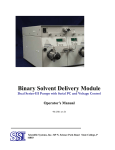
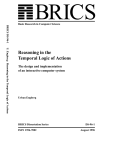
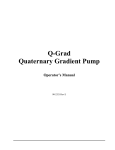
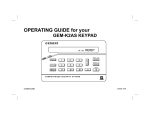
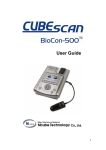
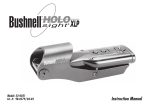
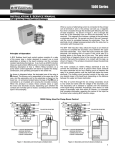

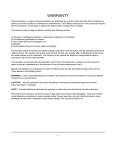
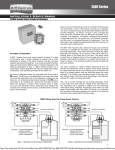
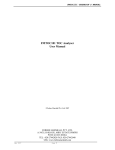
![SS HNBL-018 Owners manual HN1004-5 [EN] A3.indd - Jouef](http://vs1.manualzilla.com/store/data/006909007_1-61f91df4c9e84909195a3d6de9b86041-150x150.png)

